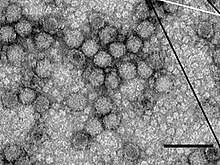Iflaviridae
Iflaviridae is a family of positive sense RNA viruses insect-infecting viruses. Some of the insects commonly infected by iflaviruses include aphids, leafhoppers, flies, bees, ants, silkworms and wasps. The name "Ifla" is derived from the name "Infectious flacherie virus", for the type species.[1] There is only one genus (Iflavirus) and 15 species in this family, including the type species Infectious flacherie virus.[2][1][3]
| Iflaviridae | |
|---|---|
 | |
| TEM of deformed wing virus (DWV) virions bar line is 100 nm | |
| Virus classification | |
| (unranked): | Virus |
| Realm: | Riboviria |
| Kingdom: | Orthornavirae |
| Phylum: | Pisuviricota |
| Class: | Pisoniviricetes |
| Order: | Picornavirales |
| Family: | Iflaviridae |
| Genus: | Iflavirus |
| Type species | |
| Infectious flacherie virus | |
| Species | |
|
See text | |
Structure

Members of this family are insect-infecting viruses that consist of positive single-strand RNA genomes translated into a single polyprotein of ~3000 amino acids long. It encodes helicase, protease and RNA-dependent RNA polymerase enzymes and four structural proteins (VP1–4). The non-enveloped capsid has an icosahedral T=pseudo3 symmetry and is around 30 nm in diameter. VP1, VP2 and VP3 form the outer portion, with VP4 located internally.[1][3] Genomes are linear and non-segmented, around 8.8-9.7kb in length.[1][3]
Life cycle
Viral replication is cytoplasmic. Entry into the host cell is achieved by attachment to host receptors, which mediates endocytosis. Replication follows the positive stranded RNA virus replication model. Positive stranded RNA virus transcription is the method of transcription. Translation takes place by ribosomal skipping. Insects serve as the natural host.[1][3]
Pathogenicity
Several viruses in this family are economically important because they are highly pathogenic to their honeybee and silkworm hosts, while others (including Dinocampus coccinellae paralysis virus, Nasonia vitripennis virus and Venturia canescens picorna-like virus) appear to cause little or no symptoms.[4]
Taxonomy
The family Iflaviridae contains one genus, Iflavirus, with the following 15 species:[1]
- Antheraea pernyi iflavirus[5]
- Brevicoryne brassicae virus
- Deformed wing virus
- Dinocampus coccinellae paralysis virus
- Ectropis obliqua virus
- Infectious flacherie virus
- Ixodes holocyclus iflavirus
- Lygus lineolaris virus 1
- Lymantria dispar iflavirus 1
- Nilaparvata lugens honeydew virus 1
- Perina nuda virus
- Sacbrood virus
- Slow bee paralysis virus
- Spodoptera exigua iflavirus 1[6]
- Spodoptera exigua iflavirus 2
- Varroa destructor virus-1
References
- "Iflaviridae". ICTV Online (10th) Report.
- Valles, SM; Chen, Y; Firth, AE; Guérin, DMA; Hashimoto, Y; Herrero, S; de Miranda, JR; Ryabov, E; ICTC Report Consortium (April 2017). "ICTV Virus Taxonomy Profile: Iflaviridae". The Journal of General Virology. 98 (4): 527–528. doi:10.1099/jgv.0.000757. PMC 5657024. PMID 28382900.
- "Viral Zone". ExPASy. Retrieved 15 June 2015.
- Dheilly NM, Maure F, Ravallec M, et al. (2015), "Who is the puppet master? Replication of a parasitic wasp-associated virus correlates with host behaviour manipulation", Proceedings of the Royal Society B, 282 (1803): 20142773, doi:10.1098/rspb.2014.2773, PMC 4345448, PMID 25673681
- Geng, Peng; Li, Wenli; Lin, Lan; Miranda, Joachim R. de; Emrich, Scott; An, Lijia; Terenius, Olle (17 March 2014). "Genetic Characterization of a Novel Iflavirus Associated with Vomiting Disease in the Chinese Oak Silkmoth Antheraea pernyi". PLOS ONE. 9 (3): e92107. doi:10.1371/journal.pone.0092107. ISSN 1932-6203. PMC 3956879. PMID 24637949.
- Millán-Leiva, Anabel; Jakubowska, Agata K.; Ferré, Juan; Herrero, Salvador (1 January 2012). "Genome sequence of SeIV-1, a novel virus from the Iflaviridae family infective to Spodoptera exigua". Journal of Invertebrate Pathology. 109 (1): 127–133. doi:10.1016/j.jip.2011.10.009. ISSN 1096-0805. PMID 22041201.